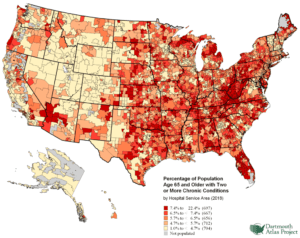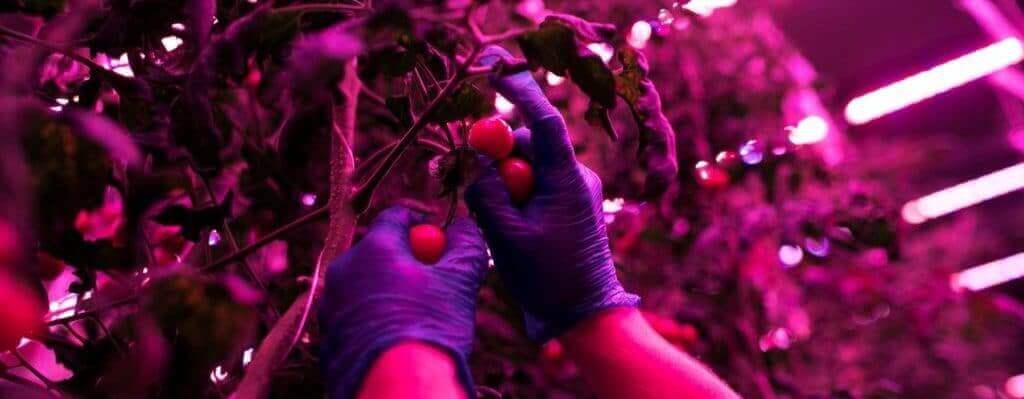I have been thinking about coronavirus, and specifically how it affects me as a home grower.
What Does This Have To Do With Growing My Own?
Obviously, one benefit of growing my own is that I don’t have to go to the dispensary or the local street corner, or call someone to deliver to my house. All of those things are supposed to increase my risk of getting coronavirus. I am not nearly as young as I look (I look young, don’t I–thanks!) and my dad, BigBud Farmer, is actually in the elderly population that is supposed to be more at risk of dying with coronavirus infections. So I wondered
As part of my random daily reading, I subscribe to a bunch of newsletters. Among them is Bloomberg News (yes, the same guy who spent $500 million or so trying to be President.) And I ran across two recent articles that explained a lot of what I was asking.
First, a comparison. One picture explains why coronavirus is not the flu, contrary to the proclamation of Cheeto Jesus.
If you are not good at charts, here is the take-home. Flu kills around 10,000 people per year. 2017-18 was a bad year and the flu killed 20,000 people.
Coronavirus has already killed more than 60,000 people in two months.
Coronavirus is NOT THE FLU.
And more recently, Cheeto Jesus has changed his story (gee, what a surprise!). Now he admits that reducing or eliminating the lockdown restrictions will result in at least 100,000 dead Americans, not 60,000 as shown in the graph above.
A lot more Americans dying from coronavirus.
Which circles back to the first question:
What Is My Personal Risk?
Well, by now, everyone knows that New York is Plague Central, and that Atlanta, Chicago and Los Angeles are not far behind.


What if you only go the grocery store or the essential dispensary every week or so? What if you don’t sit around with friends and a bong? What if you are like this guy on his couch?
What if none of your friends have coronavirus? What if none of your friends or the people around you have been tested? What if no one around you is sick? And what if you don’t live in a big city? What if you live in the country? What if you live in Wyoming or South Dakota or Lake Wobegon?
There are a lot answers in this great article from Slate magazine. I will try to unpack some of them for you, as best I can.
With current testing in America, there have been 3.9 million tests with a little more than 700,000 positive. There are 328 million people in the US. So about 1.2% of the American population has had a coronavirus test.
So far, the tests show that about 20% of the population is infected with coronavirus.
There are not enough tests to know accurately how many Americans are infected (Cheeto Jesus lies about this all the time.). Unless you have horrible symptoms, or die, or are a movie star, or are one of #trumpolini’s on VP Ponce’s visitors, you and your friends are not likely to be tested. So you are unlikely to ever find out who around you is infected.
As a consequence of this inability to test people who do not appear to be sick, there are many more people who have coronavirus walking around and no one knows who they are, not even themselves. This is how The Atlantic puts it:
“If the U.S. were a jar of 330 million jelly beans, then over the course of the outbreak, the health-care system has reached in with a bigger and bigger scoop. But every day, 20 percent of the beans it pulls out are positive for COVID-19. If the outbreak were indeed under control, then we would expect more testing—that is, a larger scoop—to yield a smaller and smaller proportion of positives. So far, that hasn’t happened.”
So it turns out that your (statistical) risk of knowing someone infected with coronavirus is pretty high. The average person knows 600 people. If you have around 600 people in your social circle, you likely know someone who has coronavirus.
If everyone in America could be tested, and the tests still showed that 20% of people are infected, then you could have as many as 120 friends with coronavirus. Most won’t have symptoms. They might not know they are sick. And if you don’t know it and they don’t know it, then you can be infected by being a friend.
Lies, Damn Lies and Statistics
That was a quote often attributed to Mark Twain, but he claims to have gotten if from Benjamin Disraeli. And that claim may have been a damned lie or a statistical guess.
There are lots of caveats to the statistics about how many people are infected and what your risk really is. The sad truth is that we are so behind the curve on this that we really don’t have a good idea of how many people are infected (the “prevalence” of the infection.)
But there are some things that you can be pretty sure of:
- People who are infected with coronavirus, whether or not they know it, can still infect other people.
- Coronavirus appears to be contagious up to two weeks BEFORE someone has symptoms.
- Most people who are infected with coronavirus are either not sick, or so mildly sick that they never get tested.
- Coronavirus is widespread in the American population, much much widespread than the flu ever was (at least since 1918.)
- Coronavirus is highly contagious.
- Without universal testing, you have no way of knowing who around you is infected and therefore is contagious.
After all, where you live makes a difference. Today. Maybe not tomorrow.
Assume you don’t live in Lake Wobegon, Minnesota “where all the women are strong, all the men are good-looking, and all the children are above average.”
I
 If you live in Wyoming or some other state or city with very few reported cases of coronavirus, lucky you. But that is today. Without a vaccine or a cure, we are basically in the dark about what happens next week or next month or next fall or next year. Like the 1918 flu pandemic that killed 50 million people worldwide, coronavirus started in the winter and spring, tapered off in the summer with quarantines, social distancing, use of masks, and things we are still doing today. Then it came back again with a vengeance when people gradually stopped doing these things and by the fall of 2018 and into 2019 it was more widespread and deadly than before.
If you live in Wyoming or some other state or city with very few reported cases of coronavirus, lucky you. But that is today. Without a vaccine or a cure, we are basically in the dark about what happens next week or next month or next fall or next year. Like the 1918 flu pandemic that killed 50 million people worldwide, coronavirus started in the winter and spring, tapered off in the summer with quarantines, social distancing, use of masks, and things we are still doing today. Then it came back again with a vengeance when people gradually stopped doing these things and by the fall of 2018 and into 2019 it was more widespread and deadly than before.
What About Strangers
Your risk of getting a coronavirus infection goes up as you increase the number of people you are in contact with. The simplest explanation is this one from Slate Magazine:
 “Here’s an instructive way to think about this. In Atlanta, the cars of MARTA, the rapid transit system, have a seating capacity of 64 and a total capacity of 96. Georgia had reported 26,000 cases as of Friday, though many experts assume the number is far higher. But assuming that is right, the chance of being on MARTA car with someone with the virus is 21 percent. Even if somehow only 10,000 people in Georgia have the virus, the chance of being exposed to someone with the virus during one single train ride is still around 9 percent. But if the real number of cases in Georgia is 50,000 or even 100,000, as some believe, the chances are 36 to 60 percent. And that doesn’t even take into account the viral particles left by the commuters who have already left the train. Nor repeated rides day after day.” [emphasis added–MJF]
“Here’s an instructive way to think about this. In Atlanta, the cars of MARTA, the rapid transit system, have a seating capacity of 64 and a total capacity of 96. Georgia had reported 26,000 cases as of Friday, though many experts assume the number is far higher. But assuming that is right, the chance of being on MARTA car with someone with the virus is 21 percent. Even if somehow only 10,000 people in Georgia have the virus, the chance of being exposed to someone with the virus during one single train ride is still around 9 percent. But if the real number of cases in Georgia is 50,000 or even 100,000, as some believe, the chances are 36 to 60 percent. And that doesn’t even take into account the viral particles left by the commuters who have already left the train. Nor repeated rides day after day.” [emphasis added–MJF]
Here is a chart that explains what happens when you go to a restaurant or a party or gather with any number of people. Obviously, this is another “lie, damned lie or statistic” but it tells me more than I knew before. Maybe you believe there are 400,000 people in the US infected with coronavirus — that is the number known as of today. You believe there won’t be any more. If so, when you go to a wedding reception with 100 people, you have a 1 in 10 chance of meeting someone infected with coronavirus.
If you believe what scientists and testing tells us, that there are likely 2 million to 4 million Americans infected with coronavirus today, then your chance of meeting an infected person at that same wedding reception is between 46 and 70%.
 If you shake hands with that infected person, or they cough or sneeze near you, or talk in your face, or don’t wash their hands before touching the spoon on the green bean casserole at the buffet, and you are not wearing a mask and gloves, then you will probably be infected by that person who doesn’t even know they have coronavirus.
If you shake hands with that infected person, or they cough or sneeze near you, or talk in your face, or don’t wash their hands before touching the spoon on the green bean casserole at the buffet, and you are not wearing a mask and gloves, then you will probably be infected by that person who doesn’t even know they have coronavirus.
Yes, so what? Again, statistics give a picture that is not specific enough but tells you something. Everybody has heard it now. You are more likely to die from coronavirus if
- You are over 65
- You are obese, diabetic, have lung disease, heart disease or high blood pressure
- You live or work in a nursing home or densely crowded conditions
- You are African-American or Latino
- You are male (yay, me??)
And in general if you have a confirmed positive coronavirus test, the current rate of death from confirmed coronavirus test is 73,211 deaths out of 1.25 million confirmed positive tests, which is a death rate of 5.8% (as of 40 minutes ago according to Wikipedia.)
Again, a statistic. Because we only test sick people and most people who are infected are not sick, the likely death rate is less than that–ONLY 2 out of 100 people or so who are infected. Do you like those odds? I don’t. I would rather not get infected.
Obviously, where you live, who you are and what you do strongly affects your risk of getting infected, your risk of getting sick, your risk of being hospitalized and your risk of death. And equally obviously, since we are operating largely in the dark and are up a creek without a paddle (or a vaccine), the simple measures are the ones we should use and hope that other people use as well–wash your hands for 20 seconds with soap, wear a mask in public places, avoid even small groups of people, stay 6 feet away from other people.
Bullshit
One of the characteristics of coronavirus and the lack of information is that this gives wide latitude to liars and bullshit artists, including #trumpolini aka Cheeto Jesus.
But here is a particularly egregious piece of bullshit that applies directly to what this blog is about: 
Marijuana Does Not Cure Coronavirus. Period. Exclamation Point.
If you grow your own and enjoy doing that, then do it for that reason. Don’t think you have a cure for coronavirus, no matter how many bullshit artists tell you that medical marijuana is a miracle. It is not. It is nice and it helps some people in ways no one fully understands–but it does not cure coronavirus.
Weed also does not cure stupidity. So don’t be stupid.
- Wash your hands. (Here is a good soap.)
- Use hand sanitizer. (Buy it here.)
- Wipe frequently touched surfaces, like doorknobs (Buy wipes here.)
- Stay home tending your plants. (If you need guaranteed seeds, get them here.)
- Wear a mask (buy masks here.)
- Gather with your friends using wifi, not in person. If you must toke with friends, get a hookah with a 6 foot hose (like this one) and a bunch of replaceable mouthpieces.
No products found.
End of Rant
So that is end of my rant. It turns out to be less fun and more work than I thought. But I want you to stay safe. And I want to keep talking with you. No one except Cheeto Jesus thinks it is alright to lose people to the CoronaPlague.

Good Growing IS Good Karma
MaryJane Farmer
https://globalnews.ca/news/5943686/cannabis-home-grow-theft-plant/
https://slate.com/technology/2020/05/coronavirus-reopening-math.html
https://www.thegrowthop.com/cannabis-news/weed-coronavirus-memes-covid-19
Last update on 2023-02-20 / Affiliate links / Images from Amazon Product Advertising API
This product was presentation was made with AAWP plugin.






